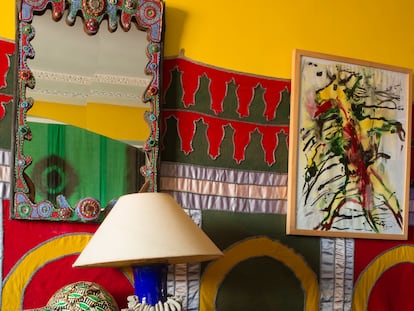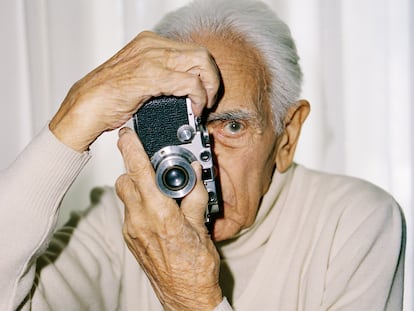The mysterious story of a Dutch family hidden in 141 undeveloped rolls of film in Italy
A package of photographs — purchased via online auction by a hobby photographer in Southern Italy — has resulted in a fascinating exhibition. There’s been a lot of curiosity about the identity of the people in the pictures
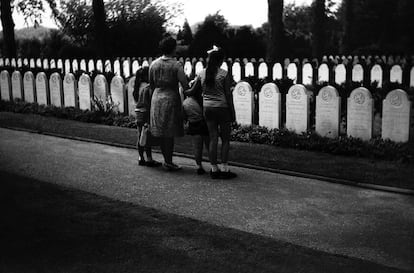
Pierluigi Ortolano is a 48-year-old factory worker. At night, he travels from his hometown — San Salvo, on the border between the Abruzzo and Molise regions in central Italy — to the interior. He has a job at Sevel: a Fiat vehicle assembly factory, an important engine of the regional economy.
Whenever he has a break, to overcome the monotony of work, he cultivates his hobbies, including photography. Between shifts in May 2017, he ended up on Catawiki — one of the most popular online auction sites. Between one camera and another, he came across an ad for a package containing 141 rolls of “printed but undeveloped” film, dating back to the 1960s in the Netherlands.
“I told myself: ‘I have to get them.’ I asked other people to help me if the price got too high,” Ortolano tells EL PAÍS. Fortunately, only one other competitor participated. When the bid reached 200 euros, he dropped out.
The package arrived a week later. On some of the canisters, labels indicated the location of the shots: “circus,” “holidays,” or “ships.” All the film came from the same brand, Agfa, suggesting that the photos were probably all taken by a single photographer. Each roll was perfectly preserved, despite the expiration date (1971). They were wrapped in a sheet of newspaper from 1969, The Randstad, which is also the name of an urban agglomeration that includes Amsterdam and 16 other cities in the Netherlands. The area is famous for its beetroot crops and sugar mills, as well as its flower parades.
When the package reached Italy, Pierluigi Ortolano left the rolls of film in the capable hands of photographer and printer Franco Glieca. From approximately 4,000 negatives, he developed the first of a long series of images that tell the love story of man and his camera, but also the story of a family over the period of about two years. In the first photo that emerged from his darkroom, three girls on bicycles are seen looking at the lens in front of a barren landscape. There’s a gloomy atmosphere, reminiscent of the twins in The Shining (1980). “If they’re all like this, let’s keep going,” an impressed Pierluigi told Glieca, upon seeing the photo.
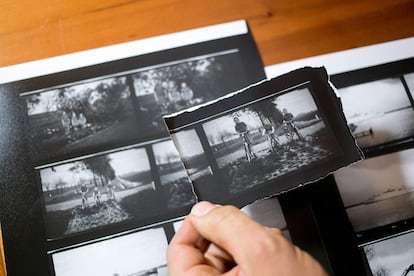
Under the name of Randstad 1969, the amateur project became a traveling exhibition, reaching cities such as Rome, Brescia and Genoa. As the photos were developed, curiosity about the subjects and their photographer grew. The topographical indications and the clues left by the prints prompted Ortolano to begin a meticulous search to follow the trail of the protagonists. In another of the images, the three girls appear again alongside a woman who is presumably their mother, while looking at graves in the Grebbeberg cemetery, where the fallen from World War II are buried. But the names on the tombstones led nowhere.
The turning point was marked by another photo. It shows one of the three girls getting off a school bus, as the other two welcome her. On the back of the vehicle, the inscription ”Pollè Garage” is visible, with a telephone number that — as Pierluigi verified after a call — turned out to be inactive. In fact, the company had ceased to exist, although he soon discovered that some retired employees had created a museum of old trams and buses. Hope seemed to fade altogether when, in February 2018, Ortolano shared the photo on a Facebook group for transport enthusiasts in the Netherlands. Not only did he receive no response, he was banned.
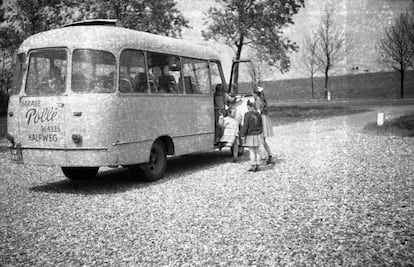
“The mystery was born there. [It was as if nobody] knew the story of this photographer. Maybe because the place where he lived isn’t very big,” Ortolano sighs. Shortly after he was banned from the Facebook group, however, a granddaughter of the company founder (Pollè) wrote to him, asking for a copy of the photo. “I’m sending you the copy, but you have to tell me who the three girls are,” he replied.
Thanks to her, Ortolano was able to discover that, at the time the photo was taken, the bus was on the Verkuyl family’s property, near a dangerous curve that was the scene of many accidents — perhaps even the one portrayed in another photo, where a car has gone off the road, with the front end smashed.
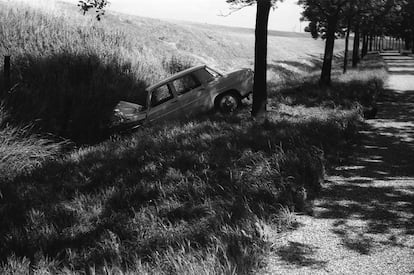
Later, an elderly man named Leo Kranenburg — president of the Historic Halfweg association, in the North Holland village of Halfweg — revealed more details about the photographer. Finally, the search was leading somewhere. Apparently, the photographer’s name was Otto Verkuyl. He was born in 1925 and died in 2008. He was known as a farmer, but in reality, his work resembled that of a small landowner, who manages landholdings for his family, his employees and the retail trade. He often traveled in his car — a Beetle — and he always had his camera with him.
In August 2018, Ortolano flew to Amsterdam. Once there, he took an Uber to the Verkuyl residence. “When I got out, my wife asked me: ‘Are you okay?’ because I had stopped speaking. It was like finding myself in a black-and-white photograph after 50 years. Only, suddenly, everything was now alive and colorful.” The door was there, within arm’s reach, but he didn’t have the courage to knock. In fact, he had just learned that Mathilda — Otto’s eldest daughter — had died in 2016, a year before he bought the rolls of film. He thought that maybe a stranger would receive him with suspicion.
The meeting
During an exhibition in August 2020 in Alfedena — a small town in the Italian province of Abruzzo — a journalist from The New York Times reached out to Ortolano, to ask him about Randstad 1969. The article never came to light, but the interest of the American newspaper was key to getting in touch with the photographer’s family. “We grew up with our father always taking photos, so it was normal for us. I also take photos. Italy is too far away, so we want to leave [the photos] there,” wrote Adriana, Otto’s third daughter, in an email from September of that same year. She attached a photo of an ad that celebrated her parents’ 50th wedding anniversary.
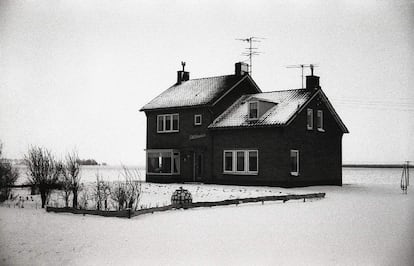
Over time, attempts to obtain more information continued, until the final tipping point. “When Pierluigi wrote to me, I thought ‘this isn’t a normal email, it’s different.’ I felt like I was in a fairy tale — it’s something you only see in movies, but this time it was real,” recalls Simone Veldhuis, 32, a customer service worker at a large Dutch wine company. She’s the eldest of Mathilda’s three children and the one who has the most memories of her grandfather Otto. She describes him as a very calm person, who had contracted ALS in his later years. The photos developed for Randstad 1969 have allowed her to fill in some of the gaps and get to know her grandfather better than she expected: “It’s very nice to see his way of thinking and see the world through the photos he took.”
Her sister, Pauline — a 28-year-old studying to be a healthcare instructure — remembers him as a great “observer.” Ortolano began to talk to her on Instagram, when he realized that she was reacting to the stories of the photographs that portrayed her mother. Thanks to this correspondence, in July 2022, five years after the purchase of the film rolls, he finally managed to set up an online call with the photographer’s granddaughters, who shared some anecdotes about their grandfather and mother.
The granddaughters helped Ortolano find Otto in the only photo that shows him on the other side of the camera. He’s enveloped by a dark mist that barely reveals his face. It was a rainy autumn day and the photographer had taken his wife and three daughters to the circus. Outside the tent, the path back to the car was littered with large puddles: he didn’t want his daughters to get wet. So, he decided to take off his shoes and take them, one by one, to their destination. His wife probably took a picture of him.
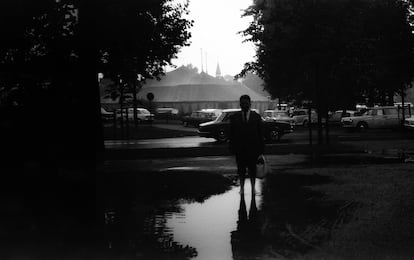
The stories told by Mathilda, Pauline and Simone paint a portrait of a very protective man who was devoted to his family. During their mother’s first week of high school, Grandpa Otto used to follow the bus, to make sure his eldest daughter got to school safely. “He was very loving and was always there for the people he cared about,” Simone recalls. The granddaughters knew about their grandfather’s passion for photography, but none of them imagined that he hid such a great talent. In fact, when he died, Otto left a gigantic amount of reels scattered in various boxes, abandoned on the floor where he lived with his family. But developing each film canister required an immense effort — after several thousands euros were spent on this endeavor, the granddaughters decided to drop the project.
Today, the family house has become a state-owned asset: it acts as a women’s shelter. Some boxes of reels, however, ended up in the hands of a family friend, who may then have given them to the person who sold them online. “For us, it’s like looking at the spirit of the time when the photos were taken, with our own experiences. [We can see] what has changed over the years in the region, but also inside the house, from the trees to the garden,” Simone notes.
Those who look at the photos — starting with Ortolano himself — wonder why they were never developed. The conclusion some have reached is that Otto was shooting for the sheer joy of shooting, with no expectation of seeing his completed work. Before being able to tie up all the loose ends, Ortolano tried to find answers by organizing a writing contest, encouraging people to write short stories based on the photos. Shortly after that announcement, the coronavirus pandemic forced people into lockdown and the contest took off. It was more successful than anticipated, with 53 entries.
The winning work, I cervi del parco di Randstad [The Deer of Randstad Park], by Rosanna Pavone, from Genoa, was written in the form of a diary, from the perspective of the photographer’s eldest daughter. The narrative voice reviewed the events of the time, but also imagined a troubled relationship between her parents, as well as a troubled one with her mother and sisters, who are very different from her. Stories like this temporarily filled the information gap about the origin of the photos, until Ortolano’s investigation and the true voice of the granddaughters allowed them to be identified.
The exhibitions
The Randstad 1969 project first took shape in December 2017 as a traveling exhibition, inside a camper-van belonging to the cultural association co-founded by Ortolano in San Salvo. Some initial details about the photos also came from a Dutch lady, who owns a house in the nearby town of Palmoli. During a walk, she came across the first printed images, which showed places that were familiar to her. In one, for example, she saw a ship that traveled between Amsterdam and New York.
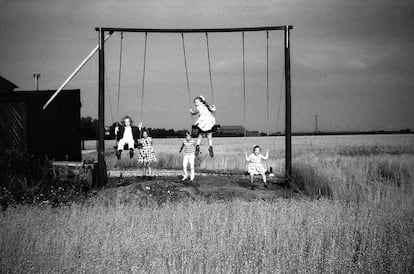
Once the work was complete, in August 2020, Randstad 1969 began travelling throughout Italy, displayed in both museums and schools. At the Podesti Calzecchi Onesti Institute — located in the municipality of Chiaravalle, in the province of Ancona — a collaboration between Eugenia Giorgetti and her students has also led to new multimedia content, a podcast and a book.
The last printed photograph shows the three girls again, together with two other boys. This time, they’re on a swing. One of the girls is turning her head backwards to look towards the camera. Only seven copies were printed, as a limited edition, to make it even more special. When Ortolano looks at it, he’s still amazed by the perfect geometry of the swing planks: it’s as if it were a frame within another frame. Only someone with significant experience could fill a shot with so much meaning, without losing the aura of mystery. Someone like Otto Vrkuyl, the Dutch photographer who never got to see the photos that told the story of his life.
Sign up for our weekly newsletter to get more English-language news coverage from EL PAÍS USA Edition
Tu suscripción se está usando en otro dispositivo
¿Quieres añadir otro usuario a tu suscripción?
Si continúas leyendo en este dispositivo, no se podrá leer en el otro.
FlechaTu suscripción se está usando en otro dispositivo y solo puedes acceder a EL PAÍS desde un dispositivo a la vez.
Si quieres compartir tu cuenta, cambia tu suscripción a la modalidad Premium, así podrás añadir otro usuario. Cada uno accederá con su propia cuenta de email, lo que os permitirá personalizar vuestra experiencia en EL PAÍS.
¿Tienes una suscripción de empresa? Accede aquí para contratar más cuentas.
En el caso de no saber quién está usando tu cuenta, te recomendamos cambiar tu contraseña aquí.
Si decides continuar compartiendo tu cuenta, este mensaje se mostrará en tu dispositivo y en el de la otra persona que está usando tu cuenta de forma indefinida, afectando a tu experiencia de lectura. Puedes consultar aquí los términos y condiciones de la suscripción digital.
More information
Últimas noticias
Welcome to the post-religion era: The idea of Christianity as the absolute truth has become obsolete
‘I thought you would like it’: The risky sexual practice popularized by TV shows and TikTok
The digitalization of tourism: ‘They promise experiences and gave us the worst possible one’
Mexican peso defies uncertainty with forecasts of a new period of stability in 2026
Most viewed
- Sinaloa Cartel war is taking its toll on Los Chapitos
- Reinhard Genzel, Nobel laureate in physics: ‘One-minute videos will never give you the truth’
- Oona Chaplin: ‘I told James Cameron that I was living in a treehouse and starting a permaculture project with a friend’
- Why the price of coffee has skyrocketed: from Brazilian plantations to specialty coffee houses
- Silver prices are going crazy: This is what’s fueling the rally
